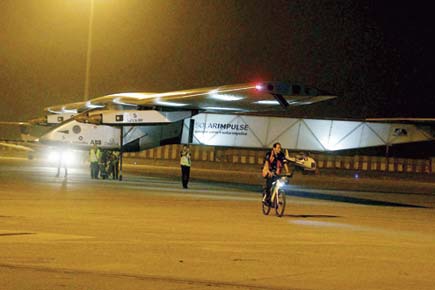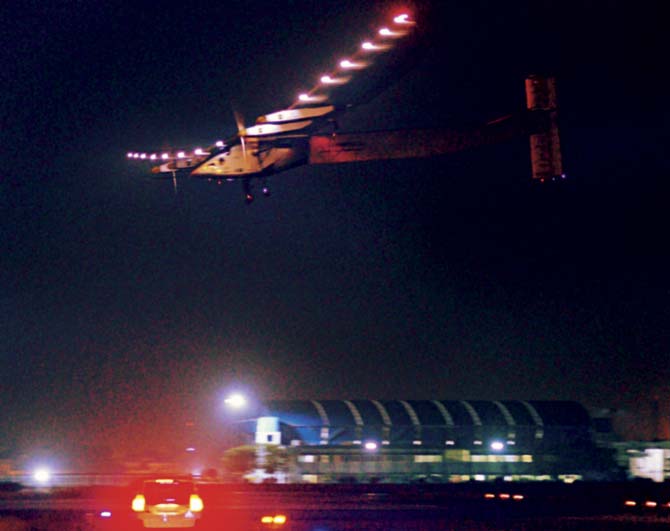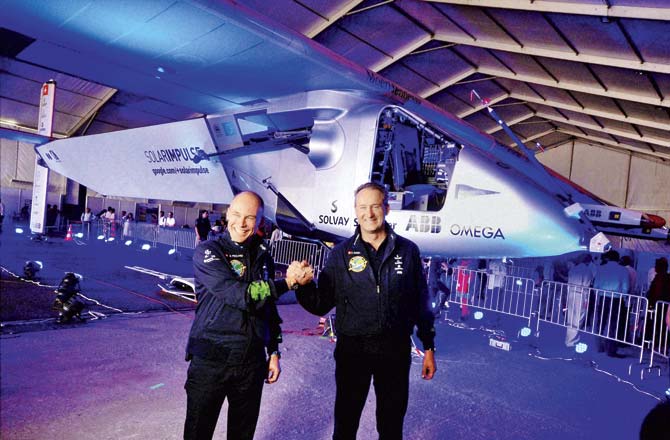Pilots of the world’s first circumnavigating solar plane, which landed in Ahmedabad on Tuesday, are now preparing for the most challenging legs of their journey crossing the Pacific and Atlantic oceans

They may have made their historic landing in Ahmedabad but the pilots of Solar Impulse 2 (Si2), the world’s first plane powered by solar energy to circumnavigate the globe, are already looking ahead to the most challenging legs of their pioneering journey crossing the vast Pacific and Atlantic oceans.

Solar Impulse 2 during its landing
ADVERTISEMENT
Powered by more than 17,000 solar cells, Si2 landed at Sardar Vallabhbhai Patel airport in Ahmedabad at 11.25 pm on Tuesday. The one-seater plane was piloted from Muscat, Oman by Bertrand Piccard, a Swiss psychiatrist and adventurist.

Afterwards at Ahmedabad airport on Tuesday. Pics/PTI
Andre Borschberg, a Swiss businessman and pilot, is the second journeyman on the mission and the duo has distributed flying duties across different legs of the 35,000-km journey that started in Abu Dhabi. “Most important thing for us is that we could put this badge on. We could put India on our sleeves,” said Piccard after landing in India yesterday.

Bertrand Piccard and Andre Borschberg in Ahmedabad
Borschberg will take over as the pilot for the next leg to the holy city of Varanasi which is expected to start by Sunday. From there they will make stops in Myanmar and China. But, by the time they reach China a month would have passed, depending on weather conditions as per the technical team. Si2 is on a key mission to spread awareness about life free from fossil fuels.
Challenge accepted
Then is the daring mission to cross the huge Pacific Ocean to enter USA, and later the Atlantic Ocean to go to either Europe or northern Africa. “We would be flying for five days and five nights from China.
This would be both technically and spiritually challenging,” chimed in Borschberg and Piccard. Yoga expert Sanjeev Bhanot has been training them to maintain their stamina and concentration since the pilots are only allowed short 20-minute naps. The ground team assembled at Ahmedabad was busy making preparations for this tricky journey over the ocean.
“We start deciding the probable trajectory for the aircraft, gauge the temperature and weather conditions that could prevail during the course of flight,” said one of the technical members of Solar Impulse 2. Until they are able to lock down on a suitable day with friendly weather, the 2,300-kg aircraft will not fly over water.
Communication while flying over the two big oceans is also vital. “There is a specially designed GPS installed in the tail of the aircraft that streams coordinates with the satellite, which then transmits information to our control team in Monaco,” explained another team member. This also helps to identify other commercial planes flying nearby.
The Air Traffic Controls falling across their alignment will be informed about the movement of Si2, which would then ensure a distance equivalent to 20 aircrafts is maintained. The $150-million aircraft has four lithium batteries, each weighing 150 kg and able to store 40 kilowatts of power. These batteries have been fitted inside the wings of this aircraft; these also power the 16 LED bulbs used at night.
More than the solar cells, it is the condition of the carbon fibre body that the engineers are worried about. “There is proper insulation that protects the solar cells. Members from the team said the solar cells can take heat up to 70 degrees Celsius. “The challenge lies in ensuring that the carbon fibre body remains intact and tackles the winds,” said a member of the technical team.
Carbon fibre is one-third the weight of paper and, thus, it becomes difficult to control the plane during turbulence. The plane’s weight only a little more than a standard SUV and nearly 174 times less than that of a Boeing 747 plane is part of the mission to promote saving energy, said Borschberg.
Brief stay
The two pilots and their 80-member crew will stay in Ahmedabad for a couple of days before taking off for Varanasi. “We will have events with our partners, with schools, universities and also with authorities because we believe in sharing this project with people as much as possible.
That is why we are going to stay (here) for three days,” said Piccard on his programme in Gujarat. While Ahmedabad is the commercial capital of Modi’s home state, Varanasi is his Lok Sabha constituency. Gujarat has the highest production of solar energy in the country.
 Subscribe today by clicking the link and stay updated with the latest news!" Click here!
Subscribe today by clicking the link and stay updated with the latest news!" Click here!







